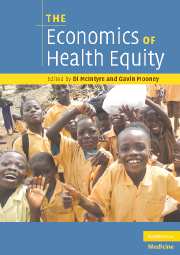Book contents
- Frontmatter
- Contents
- Contributors
- Biographies
- Acknowledgements
- Section 1 Introduction
- Section 2 Equity in general
- Section 3 Health service access
- 6 Exploring the dimensions of access
- 7 Acceptability, trust and equity
- Section 4 Equity and health systems
- Section 5 Lessons from individual countries
- Section 6 Future action
- Index
- References
7 - Acceptability, trust and equity
Published online by Cambridge University Press: 22 August 2009
- Frontmatter
- Contents
- Contributors
- Biographies
- Acknowledgements
- Section 1 Introduction
- Section 2 Equity in general
- Section 3 Health service access
- 6 Exploring the dimensions of access
- 7 Acceptability, trust and equity
- Section 4 Equity and health systems
- Section 5 Lessons from individual countries
- Section 6 Future action
- Index
- References
Summary
Summary
This chapter seeks to tease out the key elements of acceptability from evidence on health care seeking behaviour, as well as discussing its relevance and importance to health care equity. The chapter also considers the influences over patient and provider behaviour, as well as the policy actions required to address acceptability barriers and so improve health care access for disadvantaged social groups.
Understood as the social and cultural distance between health care systems and their users, the evidence suggests that the acceptability dimension of access is closely tied to patient–provider trust. It comprises the fit between lay and professional health beliefs, provider–patient engagement and dialogue, and the ways in which health care organizational arrangements frame patient responses to services. Acceptability and trust barriers are clearly disproportionately faced by socially disadvantaged groups in all societies, and influence both the distributional and procedural justice of health care. As structural and power relations influence patient and provider behaviour, and the interactions between them, an examination of acceptability barriers demonstrates, moreover, how social inequality is embedded within health care.
The chapter argues that it is important to take acceptability and trust seriously in policy debates about health care equity, notwithstanding the important physical and cost barriers also facing health care users. Tackling acceptability and trust barriers requires three sets of actions: those that strengthen the provision of care to the benefit of all groups whilst offering particular gains for socially disadvantaged groups; those that prioritize the specific needs of these groups; and those that are necessary to enable and sustain the other interventions.
- Type
- Chapter
- Information
- The Economics of Health Equity , pp. 124 - 148Publisher: Cambridge University PressPrint publication year: 2007
References
- 14
- Cited by



